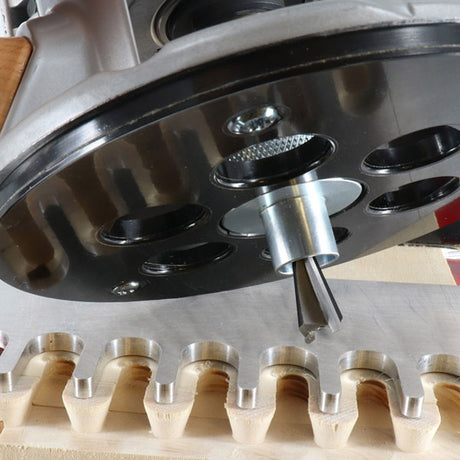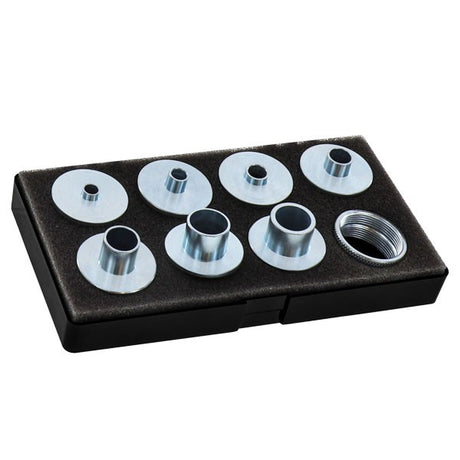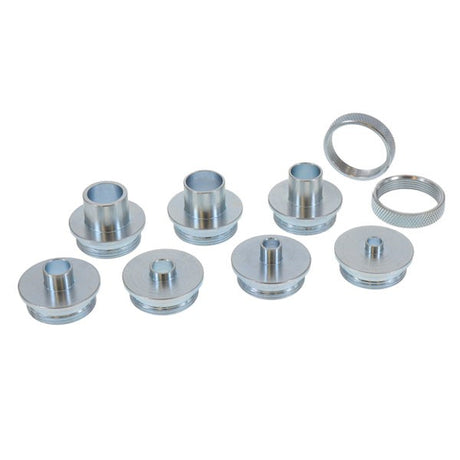Milescraft
Milescraft Metric Metal Bushing Set for Plunge Routers
$44.90$52.90Unit price /UnavailableLow stock (9 units)Milescraft
Milescraft Imperial Metal Bushing Set for Plunge Routers
$44.90$52.90Unit price /UnavailableVery low stock (3 units)Festool
Festool Copying Ring 17mm Bushing for OF 1400 Plunge Router
$57.50Unit price /UnavailableIn stockFestool
Festool Copying Ring Bushing for Screw In Guides for OF 1400 Plunge Router
$65.73Unit price /UnavailableIn stockFestool
Festool Copying Ring 13.8mm Bushing for OF 1400 Plunge Router
$65.00Unit price /UnavailableVery low stock (1 unit)Festool
Festool Copying Ring 8.5mm Bushing for OF 1400 Plunge Router
$65.00Unit price /UnavailableMilescraft
Milescraft Metric & Imperial Router Bushing Bundle
$99.90$105.80Unit price /UnavailableVery low stock (3 units)
Precision Routing Starts with the Right Router Bushings
Router bushings—also known as guide bushings or template guides—are crucial for controlled and accurate routing. These bushings fit into a router baseplate and guide the router bit along the edge of a template, allowing woodworkers to cut precise patterns, inlays, and joinery with consistency. They're widely used in cabinetry, sign-making, hinge recess routing, and a variety of template-based applications.
Router bushings typically consist of a metal or brass collar and a locking nut. The collar protrudes slightly below the baseplate, serving as a guide that rides along a jig or template’s edge. This setup allows you to follow intricate paths without cutting into the template itself. They're especially useful when used with straight bits and offset templates, giving you controlled cutting depth and profile precision.
Many router bushing kits include a variety of sizes to suit different bits and cut profiles. Some kits come with adaptor plates to make them compatible with different router brands, including Festool, Makita, Bosch, Triton, and DeWalt. If your router doesn’t natively support guide bushings, a universal sub-base plate can be a simple and effective way to upgrade your setup. Always check compatibility to ensure snug fit and minimal wobble during operation.
Using a router bushing system saves time and improves repeatability, especially when producing multiples of the same cut. For best results, secure your template firmly to the workpiece and make multiple shallow passes to prevent tear-out. Whether you're a beginner building basic jigs or a seasoned professional crafting fine joinery, a set of router bushings is a valuable addition to any routing kit.
FAQs
What is a router bushing used for?
A router bushing guides the router bit along the edge of a template or jig. It ensures the bit stays within a defined path, providing clean, repeatable cuts without damaging the template itself.
How does a router bushing differ from a bearing bit?
While both guide along templates, a router bushing attaches to the baseplate and keeps the bit centred within a guide, whereas a bearing bit has a bearing on the bit itself. Bushings offer more control, especially for internal cuts.
Do router bushings fit all routers?
Not all routers natively accept bushings. Many models require an adaptor plate or universal sub-base to fit standard guide collars. Always check compatibility with your router’s baseplate design.
What sizes do router bushings come in?
Router bushings come in various diameters, commonly ranging from 10mm to 30mm. Sets often include multiple sizes to suit different bit widths and routing applications such as hinge mortising or inlay work.
Can I use router bushings with a plunge router?
Yes, plunge routers can use bushings, provided the base supports them or has an adaptor plate installed. They’re ideal for plunge operations like creating mortises or detailed internal patterns using templates.
What materials are router bushings made from?
Router bushings are usually made from brass or stainless steel due to their strength and smooth finish. These materials provide durability and help minimise friction when guiding along templates.
How do I install a router bushing?
Most bushings are installed by inserting the collar into the router baseplate opening and securing it with a locking nut. Make sure it’s centred and flush before tightening to avoid wobble during routing.
Can I use a bushing system with my existing router table?
Yes, as long as your router table’s insert plate accepts guide bushings or can be fitted with an adaptor. Using bushings on router tables allows for template routing without relying solely on bearing-guided bits.
What are the benefits of using a router bushing kit?
A kit provides a range of collar sizes, allowing you to match your bushing to the bit and template offset needed. It improves versatility and allows you to tackle a variety of template-based projects with one system.














